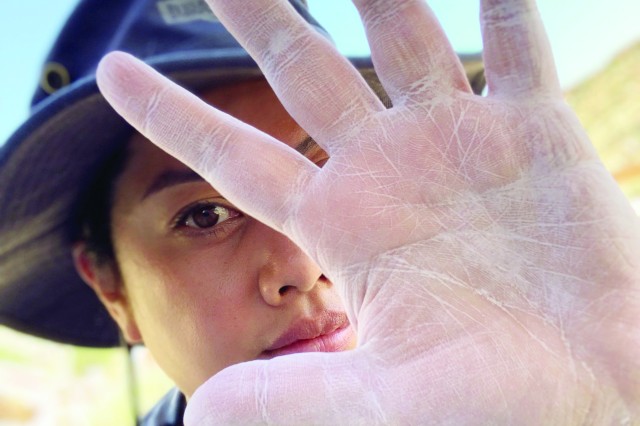
Story
My Dinosaur Dig
For years, NHM researchers (and sometimes, office folk like myself) have made their way to an exclusive Utah dig site to unearth more and more dinosaur bones.
NHM Commons—the Museum’s new wing and community hub—welcomes visitors with, among other wonders, the newest and biggest fossil Angeleno: Gnatalie. Gnatalie (pronounced “nat-ah-lee”), affectionately nicknamed for the stinging gnats that pestered its excavators during the digs, is the most complete sauropod skeletal mount on the West Coast—and the only green-colored fossil specimen on the planet. Gnatalie’s unusual bone coloring is due to infilling by the green mineral celadonite during the fossilization process.
The more than 75 feet of Gnatalie, the long-necked dinosaur, will stretch the imaginations of visitors from Los Angeles and around the world. For the first time, it will bring our storied fossils to the public with or without a ticket. The biggest specimen on display at the Museum will also be free to view for anyone.
Gnatalie’s journey to NHM is almost as long as its neck. The quarry was discovered in 2007 in Southeast Utah by researchers from NHMLAC’s Dinosaur Institute, led by Dr. Luis Chiappe, NHMLAC Senior Vice President for Research and Collections and the Gretchen Augustyn, Director of the Dinosaur Institute.
"Dinosaurs are a great vehicle for teaching our visitors about the nature of science," said Dr. Luis M. Chiappe, "and what better than a green, more than 75-foot-long dinosaur to engage them in the process of scientific discovery and make them reflect on the wonders of the world we live in!"
Gnatalie is a composite mount of multiple specimens, all belonging to a species of Diplodocus-like long-necked dinosaur (sauropods). Angelenos voted to make Gnatalie its official name in June 2024.
It takes a community to excavate a dinosaur. Meet a few who joined the dig.
The fossils that make up Gnatalie were buried in a late-Jurassic Period riverbed 150 million years ago, along with several other dinosaurs. The preservation of any bones for more than a hundred million years is incredibly rare, but Gnatalie is more extraordinary than most.
Volcanic activity around 80 to 50 million years ago made it hot enough for a new mineral to replace an earlier mineral with celadonite. This bone infilling by the green mineral during this secondary fossilization process gave Gnatalie’s skeleton an unusual green color. It will be the first green dinosaur skeleton to be mounted for display worldwide.